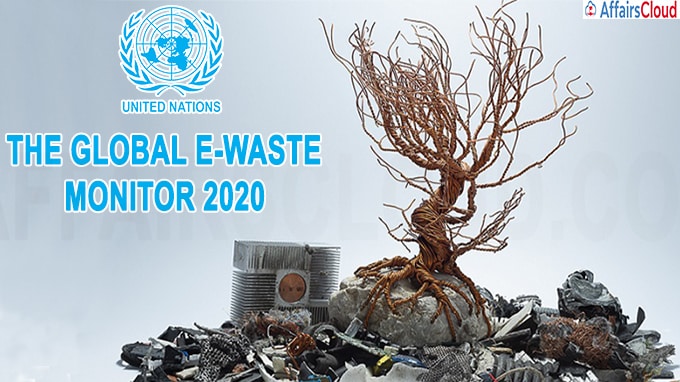 In accordance with “3rd edition of The Global E-waste Monitor 2020 report-Quantities, flows, and the circular economy potential” report, the world dumped a record 53.6 million tonnes of e-waste in 2019, an increase of 21% in 5 years. With this e-waste becomes the world’s fastest-growing domestic waste stream. Notably, this waste is enough to form a line 125 kilometres long.
In accordance with “3rd edition of The Global E-waste Monitor 2020 report-Quantities, flows, and the circular economy potential” report, the world dumped a record 53.6 million tonnes of e-waste in 2019, an increase of 21% in 5 years. With this e-waste becomes the world’s fastest-growing domestic waste stream. Notably, this waste is enough to form a line 125 kilometres long.
- China is the biggest contributor to e-waste with 10.1 million tonnes (mt) followed by the United States (US) with 6.9 mt and India with 3.2 mt at 2nd and 3rd rank respectively. Together these three countries accounted for nearly 38% of the world’s e-waste last year.
- This report is jointly prepared by the Global E-waste Statistics Partnership (GESP), formed by UN University (UNU); the Sustainable Cycles (SCYCLE) Programme, currently co-hosted by the United Nations University (UNU) and the United Nations Institute for Training and Research (UNITAR); International Telecommunication Union (ITU), and the International Solid Waste Association (ISWA), in close collaboration with the UN Environment Programme (UNEP).
- The World Health Organization (WHO) and the German Ministry of Economic Cooperation and Development (BMZ) also substantially contributed to this year’s Global E-waste Monitor 2020.
Key Points:
-Out of the total dumped e-waste, just 17.4% of it was recycled.
-The report also predicted that in global e-waste the discarded products with a battery or plug will reach 74 million tonnes by 2030.
–Asia generated the greatest volume of e-waste in 2019 — some 24.9 Mt, followed by the Americas (13.1 Mt) and Europe (12 Mt), while Africa and Oceania generated 2.9 Mt and 0.7 Mt respectively.
-E-waste in 2019 was mainly comprised of small equipment (17.4 Mt), large equipment (13.1 Mt), and temperature exchange equipment (10.8 Mt). Screens and monitors, lamps, small IT, and telecommunication equipment represented 6.7 Mt, 4.7 Mt, and 0.9 Mt respectively.
-Due to Global warming 98 million tonnes of carbon dioxide (CO2) equivalents were released into the atmosphere due to inadequate recycling of refrigerators and air conditioners.
Future Prediction – The new report also predicts global e-waste will reach 74 Mt by 2030.
Various Targets:
-In 2018, the highest policy-making body of the ITU, the Plenipotentiary Conference, established a target to increase the global e-waste recycling rate to 30 per cent by 2023.
-ITU Member States also set a target to raise the percentage of countries with an e-waste legislation to 50 per cent – or 97 countries – by 2023.(Till 2019, 78 countries adopted a national e-waste policy, legislation or regulation)
Click Here to Download the Report
Static Points:
-E-waste is a health and environmental hazard because it contains toxic additives or hazardous substances such as mercury which damages the human brain and / or coordination system.
–India is the only country in South Asia to draft legislation for e-waste.




